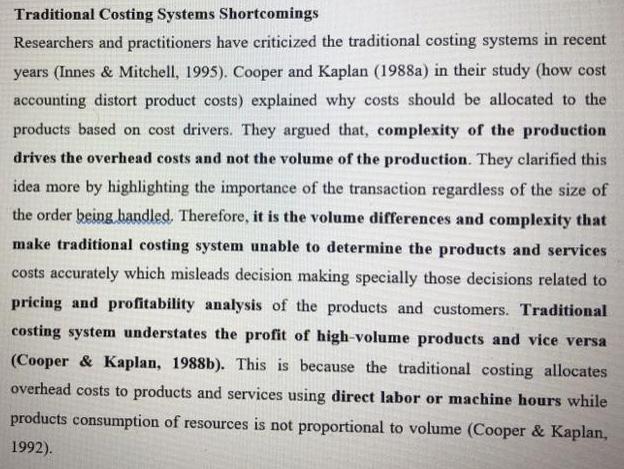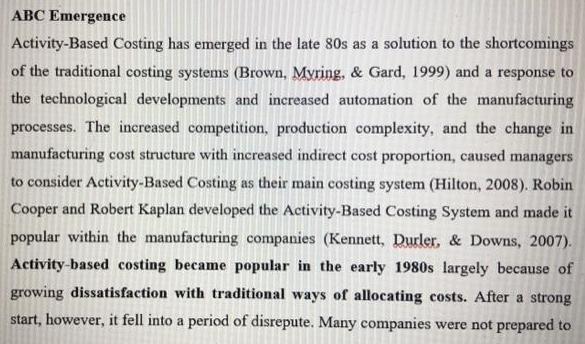Answered step by step
Verified Expert Solution
Question
1 Approved Answer
Traditional Costing Systems Shortcomings Researchers and practitioners have criticized the traditional costing systems in recent years (Innes & Mitchell, 1995). Cooper and Kaplan (1988a)



Traditional Costing Systems Shortcomings Researchers and practitioners have criticized the traditional costing systems in recent years (Innes & Mitchell, 1995). Cooper and Kaplan (1988a) in their study (how cost accounting distort product costs) explained why costs should be allocated to the products based on cost drivers. They argued that, complexity of the production drives the overhead costs and not the volume of the production. They clarified this idea more by highlighting the importance of the transaction regardless of the size of the order being handled. Therefore, it is the volume differences and complexity that make traditional costing system unable to determine the products and services costs accurately which misleads decision making specially those decisions related to pricing and profitability analysis of the products and customers. Traditional costing system understates the profit of high-volume products and vice versa (Cooper & Kaplan, 1988b). This is because the traditional costing allocates overhead costs to products and services using direct labor or machine hours while products consumption of resources is not proportional to volume (Cooper & Kaplan, 1992). ABC Emergence Activity-Based Costing has emerged in the late 80s as a solution to the shortcomings of the traditional costing systems (Brown, Myring, & Gard, 1999) and a response to the technological developments and increased automation of the manufacturing processes. The increased competition, production complexity, and the change in manufacturing cost structure with increased indirect cost proportion, caused managers to consider Activity-Based Costing as their main costing system (Hilton, 2008). Robin Cooper and Robert Kaplan developed the Activity-Based Costing System and made it popular within the manufacturing companies (Kennett, Durler, & Downs, 2007). Activity-based costing became popular in the early 1980s largely because of growing dissatisfaction with traditional ways of allocating costs. After a strong start, however, it fell into a period of disrepute. Many companies were not prepared to give up their traditional cost-control mechanisms in favour of ABC. Nevertheless, ABC has many satisfied customers. Chrysler, an American car manufacturer, claims that it saved hundreds of millions of dollars through a programme that it introduced in the early 1990s. ABC showed that the true cost of certain parts that Chrysler made was 30 times what had originally been estimated, a discovery that persuaded the company to outsource the manufacture of many of those parts. Required 1.0 Explain the differences between traditional cost accounting and activity-based costing (ABC) with proper usage of diagrams if necessary. Please organise your work by following the structure (1) definition, (2) how the accounting methods were developed-history and (3) why both methods are different. (Please use relevant journals and books when answering this part of the question. Please also refer to the mark sheet). (60 marks)
Step by Step Solution
★★★★★
3.31 Rating (148 Votes )
There are 3 Steps involved in it
Step: 1
Difference between traditional cost accounting and activity based costing 1 Definition Traditional cost accountingTraditional costing is the allocation of factory overhead to products based on the vol...
Get Instant Access to Expert-Tailored Solutions
See step-by-step solutions with expert insights and AI powered tools for academic success
Step: 2

Step: 3

Ace Your Homework with AI
Get the answers you need in no time with our AI-driven, step-by-step assistance
Get Started


